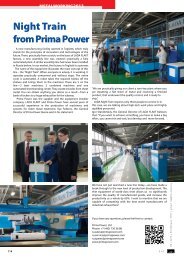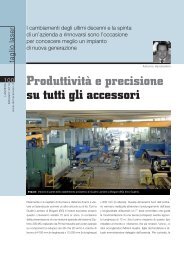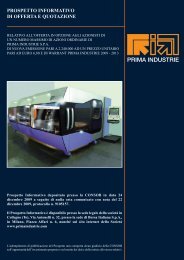Create successful ePaper yourself
Turn your PDF publications into a flip-book with our unique Google optimized e-Paper software.
TECH TIPSby Andrew McCarlie, Applications EngineerTool Holder and Turret Maintenanceon Your Turret Punch PressThe health of your turret punch /shear /laser is directly related to thecondition of the holders and their alignment in the turret. This isone of the first areas to investigate when you notice excessive toolwear, chipping of punches, punches sticking in the sheet, tool sticking in theholder, or saw tooth cutting with the auto-index stations.The first step is to make a checklist and identify the actual stations wherethe tooling is a problem. These could be both fixed and indexable holders, aswell as Multi-Tools.Next remove the punch assembly from theholder. Clean the assembly and the holder, makingsure that all grease and oil is wiped from both.Ideally, both the holder and tool should belubricated with a light 46 weight oil, such as thatused in the hydraulics. Heavy greases and gearboxoils are not recommended because they catch andattract metal dust/slivers, etc., which can turn into agrinding paste, thus jamming the tool in the holderand assembly. Grease is what is required in the autoindexrotation mechanisms only. The holders andpunch guide assemblies in your Finn-<strong>Power</strong>TP /LP /SG /SB are generally machined to closerthan 0.001" (0.025 mm) so heavy lubricants whichare often used in more open tolerances (worn)assemblies and holders of other machines are not required. In fact, they canoften cause more problems than they solve.Now with the clean upper and lower holder, take the appropriate size ofalignment tool and place the alignment punch in the upper holder and thealignment die in the lower holder of the turret.The alignment tools are machined to closer than0.0005" (0.015 mm) so they provide very accuratealignment calibration of the tool holders. As you dropin the upper tool holder alignment tool, take note ofhow much slop or movement there is between thealignment tool and the holder. Check to be sure that itslides freely over the holder key and does not bind.At this point, before you lock the turret under theram with the upper and lower alignment tools in place,you now have a good idea of how worn thetool holder may be. If you can feel excessivemovement (slop) between the alignment tooland holder (>0.002" ) then holder replacementshould be considered before continuing toalign the upper and lower holders. This isimportant if you run with 0.006" (0.15 mm)or less die clearances in your machine. It is notThe FINN-ISH LINE is a publication distributed to Finn-<strong>Power</strong> customers,prospective customers, employees, dealers, suppliers, and friends. The staff of theFINN-ISH LINE requests article ideas and letters for future publication.Editor Robert J. Kolcz rjk@finnpower.comAssociate Editor Tiina Ayaydin tiina@finnpower.comTechnical Editor Lutz Ehrlich lehrlich@finnpower.comContributing Editor Andrew McCarlie mccarlie@finnpower.comSenior Correspondent Timo Laurinen timo.laurinen@finn-power.comAll registered trademarks in this publication are property of their respective owners.a good idea to align a worn station since this does not cure theproblem of a worn station.One of the advantages of the Finn-<strong>Power</strong> turret design is that aworn upper tool holder can be swapped out in as little as 30 minutes.No turret re-bore is required.It should be noted at this point that if there is no appreciable wearin the upper tool holder, then either the tool guide assembly is wornand should be replaced or the upper to lower tool holder alignmentshould be checked.To check the upper to lower tool holder alignment – dependingupon the type of alignment tool you are using – place the loweralignment die in the die holder.Next, lock the turret up with the alignment tool under the ram.Make sure when using the 2-pin type of alignment tool that you donot engage the pins until the station is locked under the ram. A pieceof cardboard separating the two can be used to achieve this.Once under the ram, with the cardboard removed or theconnecting rod engaged, if the upper alignment tool engages smoothlyin the lower, you have upper and loweralignment (angularity andconcentricity) to within 0.0003"(0.008 mm). If the alignment tools donot engage smoothly, then the upperstation must be loosened as per thealignment procedure and moved so theproper engagement occurs.The next thing to check is thecondition of the lifter springs under thelifter pins in the tool holders. Theseperform the important function oflifting the tool up so that it follows theram after the tool has stripped from thematerial. A consequence of these liftsprings being weak is continual punchin sheet alarms on the control due tothe ram head separating from the toolon its return stroke.Lifter pins on a C station holder.Keep turret clean of all slugs andmetal slivers.Depending upon the duty cycle (heavy nibbling, 3 shifts /day) ofthe machine, these springs need to be replaced every 6-12 months. Donot replace only the lift springs that appear to be worn in a holder –replace them all. This is particularly important with the 1.25" autoindexstations.This is easily accomplished by removing the retaining ring aroundthe outer edge of the tool holder with a piece of cardboard over thepins so they do not pop out onto the turret. With the ring and lift pinsremoved, extract the lifter springs and replace them. Again, this can bedone in a very short space of time.To replace the full tonnage upper index holder, all that is requiredis to remove the snap ring on its base and remove it from its sleeve.Replacement is the reverse of removal and it usually takes less than fiveminutes. No realignment of the station is necessary as the sleeve is notremoved during this process.And finally, make sure that you keep the turret clean of all slugsand metal slivers as these can catch in and jam lower index stations(index locking alarms), tools and the shot pin cups that locate theturret locking pins (turret locking alarms). Regular weekly turretinspection and maintenance are a must. This should be carried out thesame time the tooling is inspected and swapped out where necessary.2
















